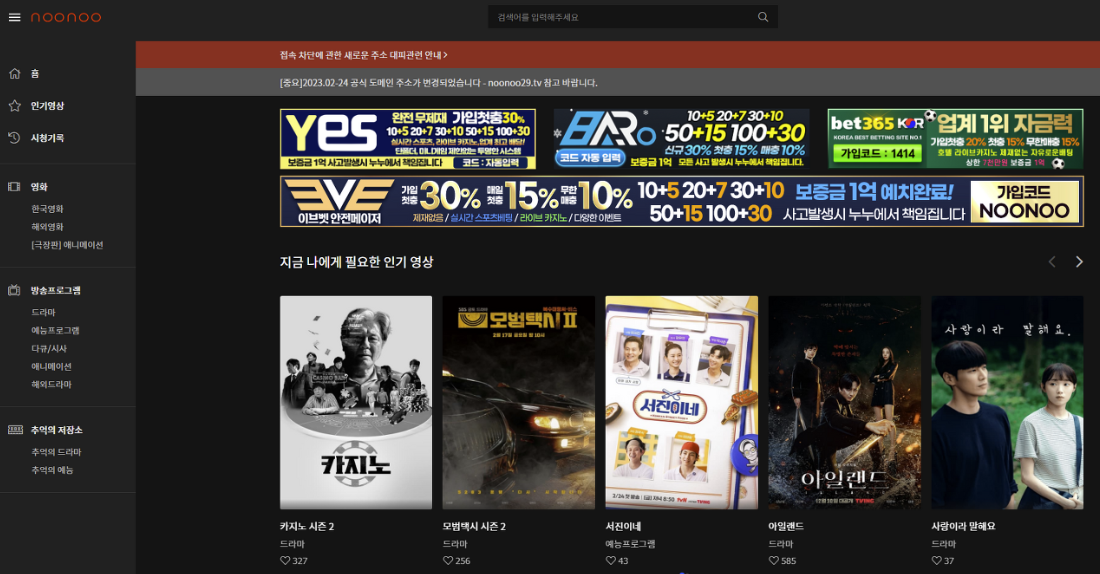The saga surrounding the former operator of NunuTV, once South Korea’s largest pirate streaming site, has taken another wrong turn for the defendant. After receiving a three-year prison sentence earlier this year, an appeal only made the situation worse. After noticing a history of recidivism and a lack of remorse, the court extended the former operator’s original three-year sentence by 18 months.
From: TF, for the latest news on copyright battles, piracy and more.
 Despite a stream of news reports that seem to suggest the opposite, there are more examples of pirate site operators surviving unscathed than there are public catastrophes.
Despite a stream of news reports that seem to suggest the opposite, there are more examples of pirate site operators surviving unscathed than there are public catastrophes.
That’s to be expected when facing finite anti-piracy resources, yet some individuals do seem to fly under the radar with very little effort. Others prefer to weigh the likelihood of enforcement against available resources and confidence in their personal skill set. For some, the strategy has proven successful, but thanks to a volatile mix of unpredictable variables, some suddenly find things going in the opposite direction.
The warning signs are often glaringly obvious to those viewing from the periphery, but for those involved, up close they may be almost invisible.
The Rise and Fall of NunuTV
Operating from July 2021 to April 2023, NunuTV (NooNoo TV) quickly gained a reputation for illegally streaming domestic and international titles to the pirating masses.
Reportedly servicing tens of millions of visitors every month, the site’s popularity was never in doubt. Neither did it go unnoticed by those increasingly concerned by its meteoric growth. Rightsholders claimed that the site facilitated over 1.5 billion views of pirated movies and TV shows, with damage to the entertainment industries estimated at five trillion Korean won (US$3.7 billion).

Whether that figure was wildly overblown or about right wasn’t the main concern. South Korean media companies and groups clearly felt strongly enough to join forces under the Video Copyright Protection Council (VCPC) to put an end to it. Facing a “stronger together” strategy in respect of legal action and the aggressive pursuit of site-blocking measures, NunuTV’s response to the latter was predictable and extremely persistent.
Blocked / Unblocked / Arrested
Every time a NunuTV domain was blocked, the site would reappear on an almost identical domain, usually with a number tagged on the end that increased incrementally; noonootv1 became noonootv2, noonootv24 became noonootv25, a pattern that continued to noonootv30 and several beyond.
Blocked / Unblocked
In the background, few if any other sites were mentioned in public as potential targets. The profile of the site meant that if rightsholders and the authorities saw value in sending a deterrent message, one option stood out above all others.
When the government announced the formation of a dedicated piracy investigation unit and VCPC became even more vocal, momentum seemed to shift. NunuTV shut down in April 2023, suggesting that the “outrageous” cost of bandwidth and anti-piracy measures had detracted from keeping the site alive. A successor site, NunuTV Season 2, enthusiastically emerged soon after, but it didn’t last.
In November 2024, a notice posted to GitHub revealed that Korean authorities had shut down TVWiki, a streaming piracy site with millions of monthly users. The site’s alleged operator who, according to reports, was also behind streaming platform OK Toon, was arrested by a special unit operating under the Ministry of Culture, Sports and Tourism.
The Shutdown Notice (translated)

A takedown notice hosted on GitHub revealed that the individual behind TVWiki and OKToon was also the operator of NunuTV. Identified in court records only as ‘Person A’, he had conveniently used the new sites to fill the void left by the original shutdown.
All three websites generated revenue from illegal gambling platform banner ads, a known aggravating factor but still quite lucrative. Authorities went on to seize assets worth 2.6 billion won (US$1.9 million), a haul that included luxury vehicles and 14 bitcoin.
Initial Sentence and a Roll of the Dice
At sentencing, the Daejeon District Court commented on the severity of the crime, and the negative impact it had on copyright holders’ revenues. Five trillion Korean won wasn’t realistic or representative of the actual damages suffered and the length of the sentence reflected that.
Initially sentenced to serve three years in prison, with the Court recognizing the 31-year-old’s admission of guilt as a positive factor, the outcome could’ve been significantly worse. Nevertheless, Person A lodged an appeal and even enjoyed partial success.
Earlier this month, the original sentence was overturned at the Daejeon District Court. Judge Park Eun-jin reduced the confiscation amount, detailed in the original sentence, from 700 million Korean won (~US$478,000) to 374.7 million Korean won (~US$256,000), accepting a claim by the defendant that some of the alleged profits may have been attributable to third parties operating separate sites, as Chosun Daily reports.
However, while the court was willing to reduce the financial penalty, it took a very different view on the prison term.
Gamble Fails to Pay Off
While the operator succeeded in saving some money, the appeal process drew attention to his history of recidivism. The court pointed to Person A’s prior convictions, indicating a pattern of criminal behavior.
“A had previously received actual prison sentences for crimes related to sports gambling sites and aiding the distribution of obscene materials, yet committed this crime,” the appellate court noted.
“When the investigation began, A closed the site and opened another, showing that the methods, means, and duration of the crime have escalated. Considering the need for strict punishment to prevent recidivism and the fact that the victimized broadcasters have petitioned for severe punishment, the original sentence was excessively lenient and unjust.”
With that, the original sentence was extended by 50%, from three years in prison to four years and six months.
Rightsholders will likely be satisfied that a clear message has been sent. Whether it will be received and acknowledged remains to be seen, but if there are gaps unfilled by locals in a national market, it’s usually just a matter of time before more elusive targets take up the slack.
From: TF, for the latest news on copyright battles, piracy and more.
 Mit dem B10 greift Leapmotor die verkaufsstarke Mittelklasse an - und das mit einem verblüffenden Preis-Leistungs-Verhältnis. Von Tobias Költzsch (Leapmotor, Elektroauto)
Mit dem B10 greift Leapmotor die verkaufsstarke Mittelklasse an - und das mit einem verblüffenden Preis-Leistungs-Verhältnis. Von Tobias Költzsch (Leapmotor, Elektroauto)  Mit dem B10 greift Leapmotor die verkaufsstarke Mittelklasse an - und das mit einem verblüffenden Preis-Leistungs-Verhältnis. Von Tobias Költzsch (Leapmotor, Elektroauto)
Mit dem B10 greift Leapmotor die verkaufsstarke Mittelklasse an - und das mit einem verblüffenden Preis-Leistungs-Verhältnis. Von Tobias Költzsch (Leapmotor, Elektroauto)  Die smarte Govee-Deckenleuchte mit 16 Millionen Farben, Alexa-Steuerung und Musikmodus ist auf Amazon zum Black Friday stark rabattiert. (
Die smarte Govee-Deckenleuchte mit 16 Millionen Farben, Alexa-Steuerung und Musikmodus ist auf Amazon zum Black Friday stark rabattiert. ( Die 1.100 Tonnen schwere und in Italien gebaute Komponente ist die erste, die über eine steuerbare Lagerung verfügt. (
Die 1.100 Tonnen schwere und in Italien gebaute Komponente ist die erste, die über eine steuerbare Lagerung verfügt. ( Ubisoft liefert erstmals seit Jahren Details zu Beyond Good & Evil 2 und sucht neues Personal. (
Ubisoft liefert erstmals seit Jahren Details zu Beyond Good & Evil 2 und sucht neues Personal. ( Grafikkartenhersteller müssen sich VRAM möglicherweise selbst beschaffen, da für Nvidia das Bündeln von GPUs und Speicher nicht mehr profitabel sein soll. (
Grafikkartenhersteller müssen sich VRAM möglicherweise selbst beschaffen, da für Nvidia das Bündeln von GPUs und Speicher nicht mehr profitabel sein soll. ( Bei Webland haben sich nacheinander zwei Storage-Cluster verabschiedet. Webseiten und E-Mail-Postfächer zahlreicher Kunden sind nicht erreichbar. (
Bei Webland haben sich nacheinander zwei Storage-Cluster verabschiedet. Webseiten und E-Mail-Postfächer zahlreicher Kunden sind nicht erreichbar. (



 Um eine bessere Leistung zu erreichen, wird ein Unterprozess eingeführt. Microsoft Teams soll so vor allem in Calls besser laufen. (
Um eine bessere Leistung zu erreichen, wird ein Unterprozess eingeführt. Microsoft Teams soll so vor allem in Calls besser laufen. ( Am Black Friday ist die Adobe Creative Cloud mit über 20 Anwendungen, Adobe Firefly KI und 100 GByte Cloud über die Hälfte reduziert! (
Am Black Friday ist die Adobe Creative Cloud mit über 20 Anwendungen, Adobe Firefly KI und 100 GByte Cloud über die Hälfte reduziert! ( Mit 2.500-mal höherer Pixeldichte sollen winzige Monitore für Brillen und Mikroskope möglich werden. Die Erzeugung von Laserlicht ist ebenso denkbar. (
Mit 2.500-mal höherer Pixeldichte sollen winzige Monitore für Brillen und Mikroskope möglich werden. Die Erzeugung von Laserlicht ist ebenso denkbar. (